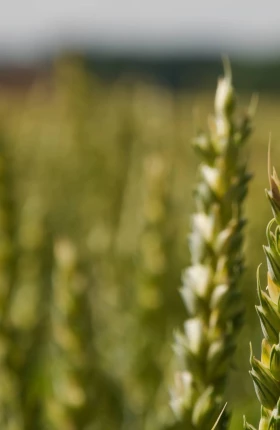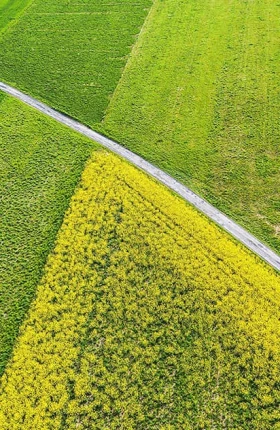Have you ever thought about the value of soil? It covers 25% of the earth’s surface. It supports all of our ecosystems, from farms and grazing land to rainforests and the vast northern taiga. It contains more carbon than the earth’s atmosphere and all its plant biomass combined. The amount of fresh water in soil that’s available to grow plants is 100 times greater than all the world’s lakes, rivers, and wetlands put together. Soil connects the lithosphere, atmosphere, hydrosphere, and biosphere. And 95% of the food we eat is dependent on it, making soil the single most important resource for agriculture to feed the world.
Yet despite soil’s importance, we are only just beginning to understand the science of it: its astonishing biodiversity when healthy and the role it plays not just in the production of food but in maintaining clean fresh water, recharging groundwater reserves, and collecting and storing the carbon that would otherwise keep warming the planet.
Maintaining healthy soil is a task not just for farmers and agricultural policymakers but also for food companies, grocers, and consumers.
What we have learned in our latest extensive research is not just about the conditions needed for the healthiest, most productive soil possible. Along with the environmental and nutritional benefits of healthy soil, the significant economic value gained by improving soil (upward of €14 billion a year in Germany alone) makes clear just how critical it is to strive in every way to optimize and maintain its health.
This is a task for all stakeholders—not just farmers and agricultural policymakers but also for food companies, grocers, and consumers. In this article we look at what makes healthy soil so critical to the well-being of the planet and how we can work together to capture its considerable economic value.
The Recipe for Healthy Soil
Soil is typically made up mostly of inorganic matter—around 45% minerals, 25% air, and 25% water. The remaining 3% to 7%, depending on the type of soil, is made up of soil organic matter (SOM), which holds the key to healthy soil. SOM helps create a robust soil structure and protects against erosion. It’s what regulates and stores water, air, and nutrients and sequesters carbon. And it supplies the resources needed by the microbes and other organisms that increase the nutrients available to plants.
SOM is made up of four distinct elements: fresh residues, resistant organic matter, humus, and the living organisms that make up soil’s biome. The first two are mostly the feedstock for the creation of humus as well as a food for the soil organisms. It’s the second two that really determine soil’s role in feeding and sustaining the crops we grow. Aside from the living organisms, humus is the most vital component of fertile soil, as it contains most of the nutrients that feed plants, stores water, and stabilizes structure.
Six key ingredients determine the buildup of SOM and hence the ability of soil to keep the three cycles going. These include sufficient moisture, right texture and structure, sufficient organisms, sufficient biomass, right pH, and temperature. (See Exhibit 1.)
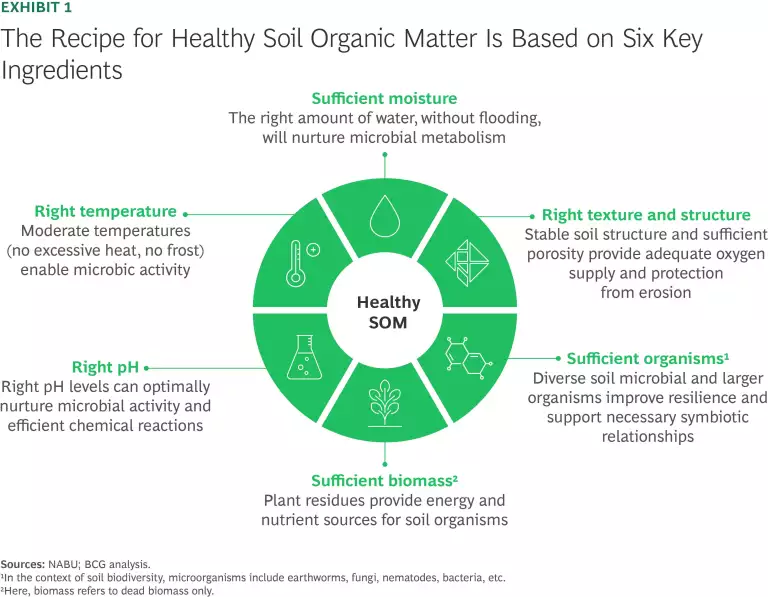
If these factors are out of balance, soil simply cannot develop the SOM needed to sustain strong and healthy plant life. Deserts, for example, don’t get enough rain, so they can’t sustain the vegetation required to maintain the carbon cycle that would enable them to build a healthy layer of SOM. By contrast, the excess water in peatlands negatively impacts the soil biome and pH levels, hindering the development of healthy soil layers for the productive cultivation of crops but boosting its important role as a carbon sink.
Healthy soil doesn’t just lead to higher crop yields and reduced erosion. It also enables less use of synthetic fertilizer, less need for mechanical irrigation, and greater yield resilience in the face of flooding or droughts through its ability to better take up and store water. Its capacity to capture and sequester atmospheric carbon can also significantly reduce the impact of emissions.
Can those benefits be quantified economically? And if so, what are they worth?
The Value of Healthy Soil
Analyzing the economic value of improved soil health is no easy task. But it is possible to gain a reasonable estimate of the increased value over time by using modern DNA fingerprinting methods to assess the soil biome for species richness and to determine its evenness of distribution as a proxy for healthy soil.
We took Germany as an example because the amount of land devoted to agriculture there, the range of soil types, and the relative soil health are well known. Then we calculated the added economic value of increasing the SOM content of the country’s soil by an average of 1.3 metric tons per hectare per year, depending on the soil type, based on data from Germany’s Federal Environment Agency and Federal Office for Agriculture and Food. This would increase the total SOM in the soil’s top layer by an average of 1% after ten years.
At that point, the economic gains would be considerable. (See Exhibit 2.) The carbon gains alone would total close to €10 billion. This includes €9.6 billion from enhanced carbon capture in soil , which would reduce the country’s CO2 emissions by about 43 million tons. That’s comparable to eliminating the CO2 emissions from around 18 million cars, or about a third of all of Germany’s cars. An additional €0.1 billion would be gained from decreased CO2 emissions due to reduced fertilizer use. Moreover, because the production of nitrogen fertilizer accounts for around 2% of global CO2 emissions, every reduction in fertilizer use helps lower those total emissions.
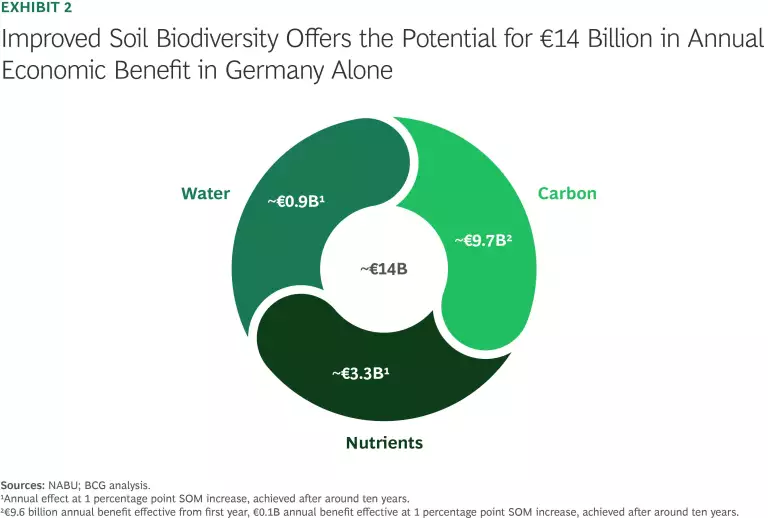
There would also be gains in the soil’s nutrient content, a total annual benefit of about €3.3 billion, mainly from improved crop yields, providing the equivalent of plant-based calories for approximately 30 million people, and through further reductions in the need for synthetic fertilizers, which would also reduce Germany’s dependence on imported fertilizer.
An additional €0.9 billion in benefit would come from healthy soil’s capacity for optimum water management. Enhanced resilience during droughts would increase total yields in Germany by €0.7 billion, potentially increasing German wheat exports by around 12% in dry years and contributing to the country’s exports to net-importing countries like those in the Global South. Reduced need for irrigation due to the soil’s greater ability to hold water would conserve approximately 900 million cubic meters of irrigation capacity, for a savings of €0.2 billion.
Promoting Healthy Soil Through Sustainable Agriculture
As we’ve shown, achieving the economic benefits of healthy SOM requires the rapid optimization of the six key ingredients that determine soil’s overall health, which in turn depend on a variety of agricultural practices.
These ingredients can be influenced to varying degrees by several above-ground farming practices often associated with regenerative agriculture . Minimizing tillage, for example, can improve soil structure, increase water infiltration and holding capacity, and prevent the decrease of soil organisms. Cover crops can help cool the soil and keep it moist, add nutrients and carbon, enhance microbial activity, and increase the available biomass to feed the soil microbiome. (See Exhibit 3.)
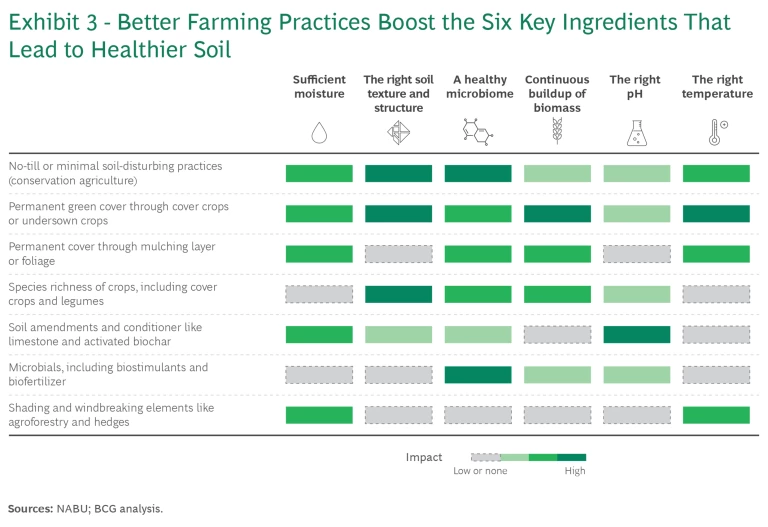
While the value of these and other practices is well known, further action is needed in three critical areas if we are to reap the full potential of healthy soil:
Increased Awareness. The entire agricultural value chain, from farmers, distributors, retailers, consumers, and society at large, must be made aware of the importance of soil health and biodiversity. Farmers need to be shown the economic value of healthier soil and taught the techniques that can promote it. Agriculture companies and distributors should be encouraged to develop and sell equipment, products, and services that are beneficial to soil biodiversity. And food companies and retailers should develop, promote, and sell healthier products that can be grown using regenerative agriculture methods.
A Paradigm Shift in Research and Data. The amount and quality of the research that has been carried out on soil biodiversity to date lags far behind the major advances in above-ground plant research now taking place, from new breeding technologies to CRISPR-based gene editing. Further research is needed if we are to fully understand soil’s contribution to life on the planet—including greater analysis of SOM and its microbial processes and drivers as well as the relationship between above- and below-ground biodiversity, all tailored to regional specifics. It is also critical to conduct more field trials regarding soil biodiversity and to improve the quantity and quality of the data available in soil databases. Finally, better methods and standards for measuring and assessing soil biodiversity like DNA fingerprinting must be refined and advanced to create a common perspective on “what good looks like.”
The health of our soil will not improve without an ongoing effort to institute new policies and incentives.
Greater Investment. The health of our soil will not improve without a wide and ongoing effort to institute new policies and incentives that support practices promoting soil biodiversity. Regulators should promote investment in public research projects to understand the drivers of soil biodiversity and enact policies that encourage the use of above-ground practices that stimulate such biodiversity. Farmers should be encouraged to adopt these practices through direct incentive programs, including loans and other financial mechanisms. Companies and funds should direct more money into new technologies that will advance our understanding of soil biodiversity, its interdependencies with other economic and environmental factors, and its effects on the broader ecosystem. And clear standards for how to measure soil biodiversity, and how frequently, should be defined to tie incentives for farmers to concrete biodiversity outcomes.
It’s simple: soil is the source of life on Earth. And healthy soil—rich in the organisms, organic matter, and nutrients that nurture the land—leads to more resilient crops, better food, lower carbon emissions, and improved local water management. The actions we begin carrying out now through more sustainable farming practices, further research, and supportive policies will pay off not just in real economic terms but in the quality of life on our planet.
This content was developed in collaboration with NABU.
About NABU
www.NABU.de
www.birdlife.org






